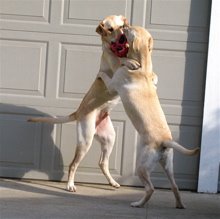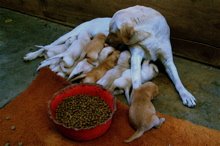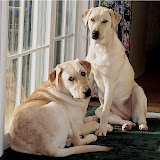Great Online finds . . .
The Lab through a Lover’s Eyes:
What It’s Like to Live With a Field Trial Champion
[excerpt]
The reasons that Labradors give the impression of being hard-headed is because they are physically insensitive. We have bred the Labrador to go through ice and briars where no man would go to retrieve a duck, so you can’t easily hurt them, which in a way, is why they’re a good dog to have around kids. People put a leash and buckle collar on them and try to keep them from pulling and when that Labrador doesn’t even notice, people say, "look at the stubborn dog." I would say, "No, that’s not a stubborn dog, he’s just physically insensitive." I don’t think that they are emotionally insensitive. If you’re willing to train in a way that says to the Labrador, “Hey, I’m here, I intend to be a part of your world.” I have found that Labradors will turn around and say‚‘Well, glad to meet you, what would you like me to do for you’?”Yes, my dogs come from some of the finest field trial champion breeding lines but they are our pets and companions not hunting or trial dogs. And with simply a consistent exercise routine and basic training they are the best companions anyone could want. Of all the breeds of dogs Labradors offer the greatest challenge for the greatest reward. They are constantly learning which is what makes them such great members of the family. Labradors are some of the most emotionally intuitive dogs because of their love to please.
~~~~~~~~~~~~~~~~~~~
Get The Facts: What’s Really in Pet Food
Animal Protection Institute
[excerpt]
What most consumers don’t know is that the pet food industry is an extension of the human food and agriculture industries. Pet food provides a market for slaughterhouse offal, grains considered “unfit for human consumption” and similar waste products to be turned into profit. This waste includes intestines, udders, esophagi, and possibly diseased and cancerous animal parts.~~~~~~~~~~~~~~~~~~~
Safety Tips and Smart Ideas:
[excerpt]
I didn't realize where I had read this great tip - "go to your place" before getting fed - until I started going back through some of my bookmarks to share on the blog. This tip in particular with a two dog household has been invaluable. Some of the ideas expressed here I don't completely agree with but the information is still worth reviewing.You can also teach your dog to "go to your place" before getting fed, which is especially helpful for dogs prone to begging at kitchen counters and dinner tables.
- It is good practice to always have your dogs earn their treats and food. Teach your pet commands such as come, sit and down, then give a command for the dog to obey before you provide the meal or treat. Dogs like the opportunity to show that they understand their people and enjoy interaction that leads to rewards and praise. Other advantages of teaching dogs to take food only upon your command: your pet will be less likely to try to steal food, ingest unauthorized substances indoors or outdoors, or accept treats from strangers.
- "Go to your place" is an extremely useful command when you're cooking, cleaning or engaged in any activity in which the dog's interference could lead to distraction and injury. You can designate a place, say, in the far corner of the kitchen or family room, and place a mat or dog bed there. Teach your dog to associate that place with a special word, such as "place," "spot" or "bed." Then, using positive reinforcement, incorporating praise and small treats as rewards, teach him to "go to your place." This gives the dog something good and acceptable that he can do.
~~~~~~~~~~~~~~~~~~~
Where to hike with your dog: (Northern California Area)
[excerpt]
Bay Area Hiker was created to fully explore the diverse and wonderful spectrum of hiking in the San Francisco bay area. This is a work in progress, so if you want to share your thoughts about any hikes that are not yet featured, drop me a line.~~~~~~~~~~~~~~~~~~~
Featured hikes will range geographically from around Robert Louis Stevenson State Park to the north, to Mount Diablo in the east bay, Henry Cowell State Park to the southwest, and Henry Coe State Park to the southeast.
The Vinegar Institute
With so many commercial cleaning product out there that are not safe or less than ideal for a household with pets I began using vinegar for cleaning my kitchen floors. I use a 1:1 vinegar:water and it works beautifully on my linoleum. Check out the webiste for more ideas.
~~~~~~~~~~~~~~~~~~~
Adolescence: The Teenage Dog from
[THE CANINE BEHAVIOR SERIES]
[excerpt]
Some of the suggestions in the article may seem general, but there are really some great specific suggestions. For instance, with two dogs I knew that the first year was going to include training. I just didn't realize at first how valuable training would be.
- If you got your dog as a puppy and provided good training, you have an advantage when adolescence arrives but your work is not done. The adolescent dog needs training experiences that the puppy was not ready for. The adolescent dog has questions that didn’t occur to the puppy.
- Best of all, the adolescent dog is ready to begin to bond with you in a whole new way, to form a real bond. Puppies “love everybody,” and if you have a puppy who hates everyone but you, beware! That puppy is not likely to have a good adult temperament.
- Adolescent dogs are ready to make distinctions about the world and the people and other dogs in it. You become an important person in this dog’s life, a beloved partner, if you earn it. This is the time that good leadership with your dog, including good management, good handling and good training, begin to really show results. This is when your dog becomes your dog by the dog’s choice.
- Stay in training classes with your adolescent dog until at least a year of age. Many dogs will need training classes longer. Attend training class with your dog each week and practice the class homework every day. Apply the training in all possible situations so that it becomes integrated into your life with your dog, keeping communication clear between the two of you. Working with a private trainer is a reasonable alternative to classes, provided you and your dog also work in controlled situations around other dogs as you would in a class.
- Be patient with your dog. Don’t interpret your dog’s error during a training session as deliberate defiance. The dog needs to ask questions, and you will be wisest to answer those questions kindly as well as consistently. The dog won’t be any better trained because you get mad in the process.
- As a matter of fact, training done in a playful tone is more effective than getting mad, because this is the most receptive state of mind for learning—and that goes for your brain as well as the dog’s! Have fun when training, and make it fun for the dog, too. Hold the line on the limits of behavior because the dog needs this from you. But don’t fault the dog for having questions. That’s the nature of an adolescent.
Start early, the day they come home, progress to indoor puppy class by at least 3 months, and stick with training well into 18 months especially those of us who have big dogs.















No comments:
Post a Comment